This blog takes readers on a journey through five beaches where Allied forces landed during the D-Day invasion, including Utah Beach in Normandy, France. The blog visits each beach, exploring its history and significance, as well as stopping at museums, memorials, and landmarks such as Le Roosevelt Café and Pointe du Hoc.
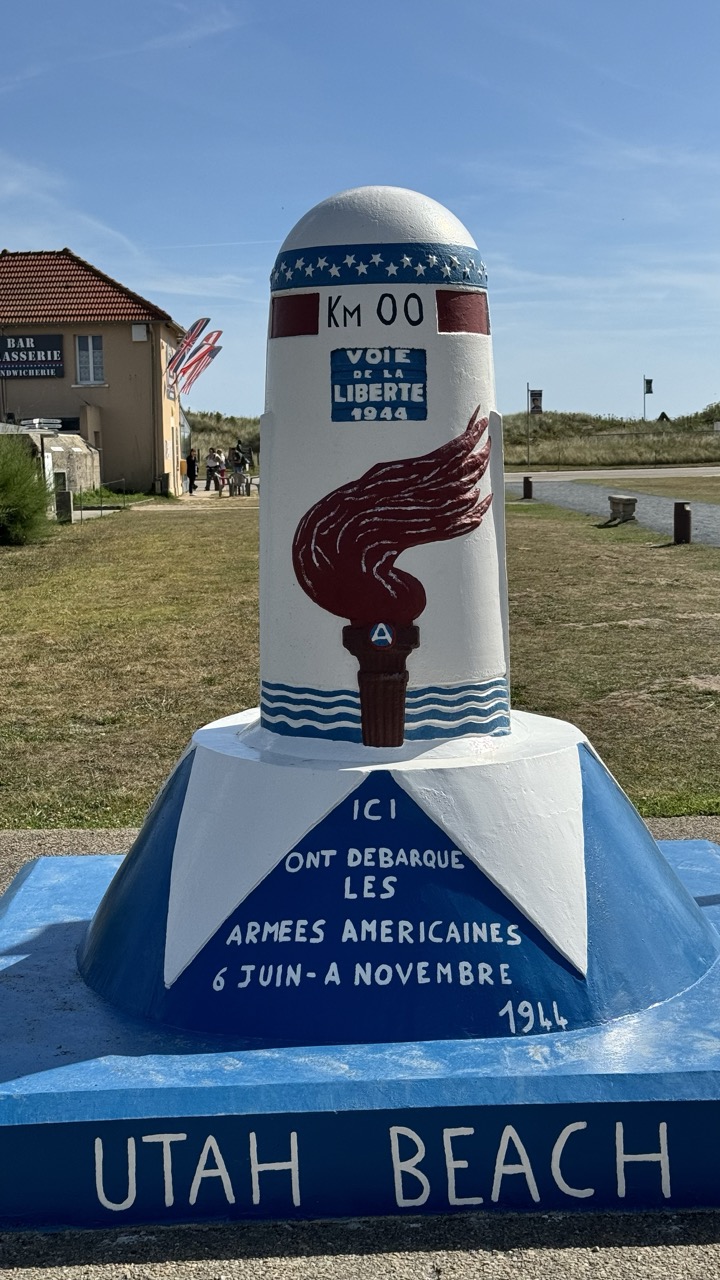

1. Overall Rating (0–10) — 7.5
This photograph captures a powerful and historically resonant monument at Utah Beach, where the American forces landed during D-Day. The composition emphasizes the memorial’s symbolic strength, with clear text and bold imagery conveying a sense of remembrance and national pride. While the image is technically sound and emotionally grounded, the slightly cluttered background and flat lighting prevent it from achieving a more cinematic or deeply evocative quality.
2. Composition (0–10) — 7.0
The monument is centered and well-framed, drawing the viewer’s eye directly to the key elements. The diagonal base and angled text create visual interest, though the background distractions—such as the building and people—slightly reduce focus on the primary subject.
3. Lighting (0–10) — 7.5
Bright, natural daylight enhances the monument’s colors and legibility. The clear blue sky provides a strong contrast, emphasizing the white and blue tones of the structure, though the overhead sun creates minimal shadowing, slightly flattening the sense of depth.
4. Color & Tone (0–10) — 8.0
The palette is striking and symbolic—white, blue, and red dominate, reflecting the American flag and evoking patriotism. The colors are vibrant and well-saturated, with the deep blue base and red torch creating a strong visual anchor.
5. Creativity (0–10) — 7.0
The image is straightforward and documentary in style, focusing on clarity and historical accuracy. While not particularly inventive in framing or perspective, it effectively communicates the monument’s significance through its direct and unambiguous presentation.
6. Technical Quality (0–10) — 8.0
The image is sharp and well-focused, with clear text and fine details visible on the monument. The exposure is balanced, and the camera’s resolution captures the textures of the painted surface and surrounding environment with precision.
7. Emotional Impact (0–10) — 8.0
The photograph carries a strong sense of solemnity and reverence, honoring the sacrifices made during the Normandy invasion. The visible text and historical context evoke a powerful connection to the past, inviting reflection and respect.
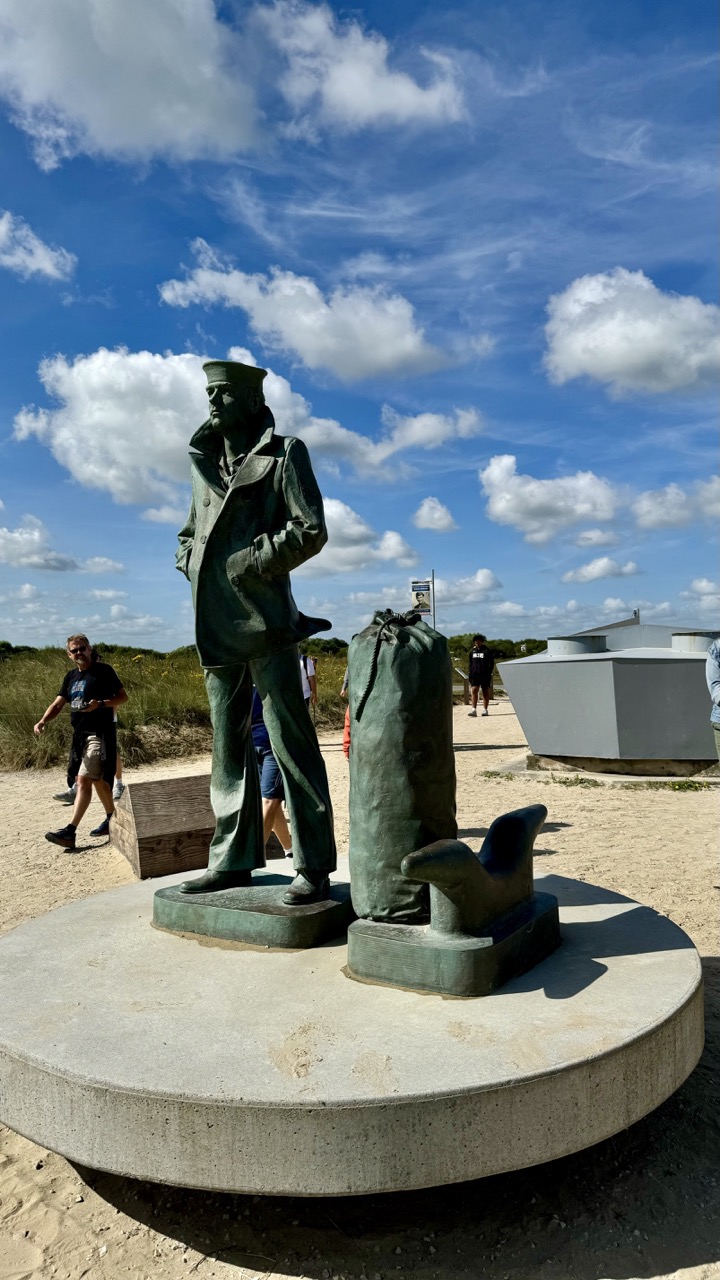

1. Overall Rating (0–10) — 7.0
This photograph captures a striking monument under a vast, dynamic sky, where the interplay of natural light and human presence evokes a sense of historical reflection. The bronze statue, weathered and contemplative, stands as a solemn tribute, while the casual tourists in the background ground the scene in the present. The composition balances monumentality with everyday life, though the slightly cluttered surroundings and flat lighting prevent it from achieving greater visual cohesion.
2. Composition (0–10) — 6.5
The statue is well-placed on a circular base, drawing the eye, but the scattered people and background structures create visual distractions. A tighter crop would enhance focus on the monument.
3. Lighting (0–10) — 7.0
Bright, natural daylight illuminates the scene, casting clear shadows and highlighting the texture of the bronze. The overhead sun creates strong contrast but slightly flattens the depth of the sky.
4. Color & Tone (0–10) — 7.5
The vibrant blue sky and fluffy white clouds create a dramatic backdrop, complementing the green patina of the bronze. The earthy tones of the sand and concrete provide grounding contrast.
5. Creativity (0–10) — 6.5
The juxtaposition of a solemn monument with casual visitors adds narrative depth, suggesting a dialogue between history and memory. While not overtly artistic, the scene carries emotional resonance.
6. Technical Quality (0–10) — 8.0
The image is sharp and well-exposed, with clean details in both the foreground and background. Focus is consistent across the main subject.
7. Emotional Impact (0–10) — 7.0
The statue’s contemplative pose and expansive sky evoke a sense of reverence and reflection, inviting the viewer to consider the weight of history. The presence of modern life adds a layer of poignant contrast.


1. Overall Rating (0–10) — 7.0
This photograph captures a solemn and reflective moment at a war memorial on a sunlit beach, where history and nature converge under a vast sky. The juxtaposition of the American and French flags, the commemorative plaque, and the visitors gazing toward the sea evokes a sense of remembrance and shared sacrifice. While the composition is strong and the symbolism clear, the image’s emotional weight is slightly tempered by the casual presence of the figures, which softens the monumentality of the site.
2. Composition (0–10) — 7.5
The two flags frame the scene symmetrically, guiding the eye toward the central monument and the horizon beyond. The placement of the visitors adds narrative depth, while the low angle emphasizes the monument’s significance, creating a balanced and purposeful arrangement.
3. Lighting (0–10) — 8.0
Bright, natural sunlight enhances the clarity and color of the scene, casting crisp shadows that define form and depth. The high contrast between the dark stone and the bright sky adds visual drama, while the soft clouds lend a serene quality to the sky.
4. Color & Tone (0–10) — 7.5
The vivid blue of the sky and the deep red, white, and blue of the flags create a striking palette, complemented by the earthy tones of the sand and green dune grass. The overall tone is clear and vibrant, with a natural warmth that enhances the sense of place.
5. Creativity (0–10) — 7.0
The image effectively blends historical commemoration with personal reflection, using the setting and composition to tell a layered story. The inclusion of visitors adds a human element that grounds the monument in contemporary memory.
6. Technical Quality (0–10) — 8.5
The photograph is sharp and well-exposed, with fine detail visible in the plaque’s inscriptions and the texture of the sand. The focus is consistent across the frame, and the dynamic range captures both the bright sky and shaded areas with clarity.
7. Emotional Impact (0–10) — 7.5
The scene resonates with quiet reverence, evoking a sense of awe and respect for the sacrifices commemorated. The vastness of the sea and sky, combined with the stillness of the moment, invites contemplation and connects the viewer to a larger historical narrative.
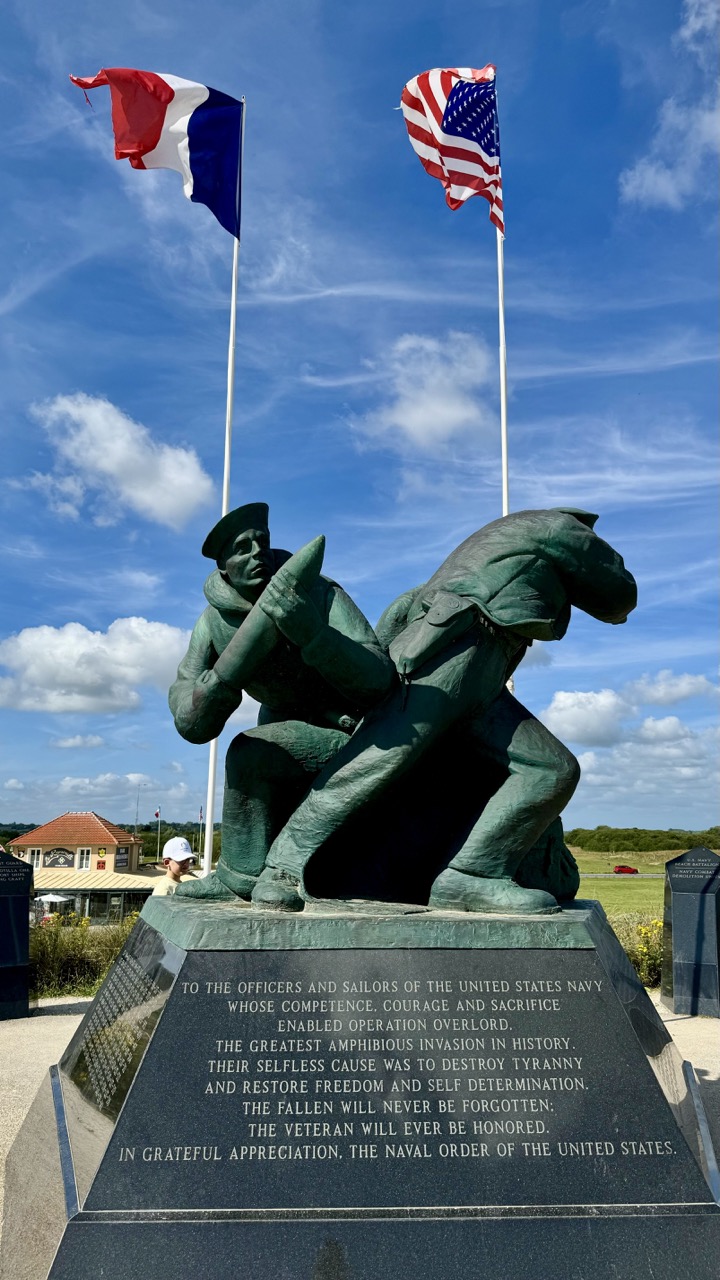

1. Overall Rating (0–10) — 8.0
This photograph powerfully captures a solemn war memorial under a vast blue sky, where the interplay of national symbols and human sacrifice evokes both pride and reflection. The composition balances the monument’s gravity with the openness of the landscape, while the flags fluttering above imbue the scene with a sense of enduring legacy. Though the inclusion of a visitor in the frame slightly disrupts the monument’s solemnity, the image succeeds as a poignant tribute to valor and remembrance.
2. Composition (0–10) — 8.0
The statue is centered and dominates the frame, with the flags rising symmetrically on either side, creating visual balance and reinforcing the theme of alliance. The low angle enhances the monument’s grandeur, while the background elements—building, trees, and open field—provide context without distracting.
3. Lighting (0–10) — 9.0
Bright, natural sunlight illuminates the scene with clarity and depth, casting subtle shadows that emphasize the texture of the bronze and the folds of the flags. The vibrant blue sky and scattered clouds enhance the image’s openness and reinforce the emotional tone of hope and remembrance.
4. Color & Tone (0–10) — 8.0
The rich green of the patinated bronze contrasts strikingly with the bold red, white, and blue of the flags and the deep blue of the sky. The color palette is both patriotic and harmonious, with a natural tonal range that enhances the monument’s solemnity and dignity.
5. Creativity (0–10) — 7.5
The image is rooted in documentary realism, but the careful framing and timing—capturing the flags in motion—elevate it beyond mere record. The juxtaposition of the historical monument with the modern visitor adds a subtle narrative layer, inviting contemplation on memory and continuity.
6. Technical Quality (0–10) — 9.0
The image is sharp and well-exposed, with excellent detail in both the monument and the sky. Focus is precise, and the resolution captures the texture of the bronze and the crispness of the inscriptions.
7. Emotional Impact (0–10) — 9.0
The photograph conveys a deep sense of reverence and solemnity, evoking the weight of sacrifice and the enduring importance of freedom. The viewer is drawn into the scene not just as an observer, but as a participant in a shared memory.
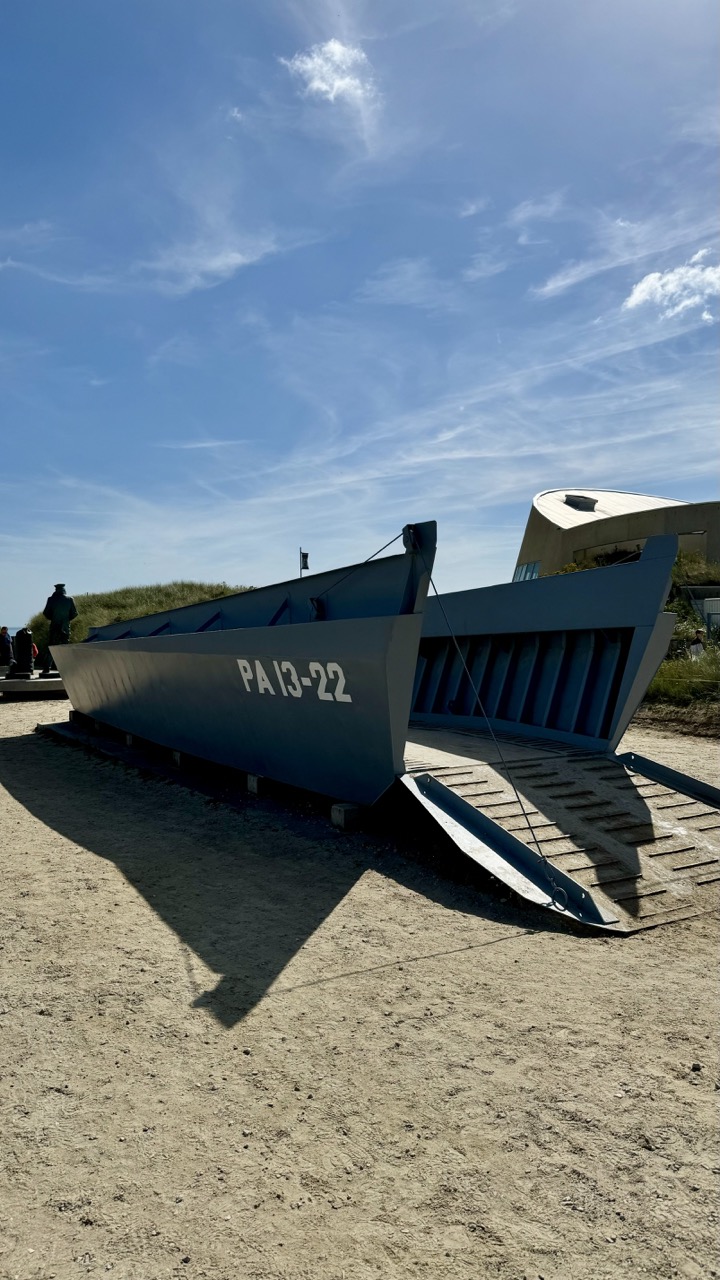

1. Overall Rating (0–10) — 7.0
This photograph captures a solemn and historically resonant scene, with a preserved military landing craft set against a vast, open sky. The juxtaposition of the weathered vessel and the bright daylight evokes a quiet reverence for the past, while the expansive composition grounds the object in its memorial context. Though the image is strong in mood and subject, the lack of human engagement and slightly awkward framing temper its emotional punch.
2. Composition (0–10) — 6.0
The low-angle perspective emphasizes the scale of the landing craft, but the off-center placement and tilted horizon create a subtle imbalance. The large shadow in the foreground draws the eye but also competes with the main subject.
3. Lighting (0–10) — 7.5
Strong, directional sunlight enhances texture and form, casting a long, dramatic shadow that adds depth. The bright blue sky contrasts sharply with the gray hull, highlighting the craft’s silhouette and contributing to the image’s clarity.
4. Color & Tone (0–10) — 6.5
The palette is restrained, dominated by blues, grays, and earth tones, which suit the historical tone. While the colors are accurate, they lack vibrancy, giving the image a slightly muted, documentary feel.
5. Creativity (0–10) — 7.0
The choice to frame the landing craft within its memorial environment suggests a narrative of remembrance and history. The inclusion of the distant building and figures adds context, though the composition could be more deliberate in guiding the viewer’s gaze.
6. Technical Quality (0–10) — 8.0
Sharp focus and clean detail are evident throughout, particularly on the boat’s hull and text. The exposure is well-managed, with no significant over- or underexposed areas.
7. Emotional Impact (0–10) — 6.5
The image conveys a sense of quiet dignity and historical weight, but the distance between the viewer and the subject—both physically and compositionally—limits the emotional resonance. It invites reflection but does not demand it.


1. Overall Rating (0–10) — 6.0
This photograph captures a poignant juxtaposition between history and memory, with a preserved WWII tank standing as a silent sentinel under a vast sky. The woman in pink, dwarfed by the machine, evokes a sense of scale and reflection, grounding the image in human experience. While the scene is rich with historical resonance, the composition feels slightly unbalanced and the lighting lacks dramatic depth, softening the emotional weight of the moment.
2. Composition (0–10) — 5.5
The tank dominates the frame, but the foreground pavement and the woman’s placement on the right edge create a slight imbalance. A tighter crop or shift in perspective could better unify the subject and viewer.
3. Lighting (0–10) — 6.0
Natural daylight provides even illumination, highlighting the tank’s details without harsh shadows. However, the overcast sky tempers the contrast, muting the mood and reducing visual drama.
4. Color & Tone (0–10) — 6.5
The olive green of the tank contrasts effectively with the blue sky and the woman’s bright pink, drawing attention to the human element. The overall palette is natural but lacks vibrancy, leaning toward muted realism.
5. Creativity (0–10) — 6.0
The image succeeds in telling a story of remembrance and scale, using a common tourist moment to reflect on war’s legacy. However, the approach is straightforward, with little stylistic experimentation.
6. Technical Quality (0–10) — 7.5
The focus is sharp on the tank and subject, with good detail throughout. The exposure is balanced, and the image is free of noticeable flaws.
7. Emotional Impact (0–10) — 6.5
The scene resonates with quiet contemplation, evoking a sense of reverence and the passage of time. The human figure adds intimacy, inviting viewers to reflect on the weight of history.
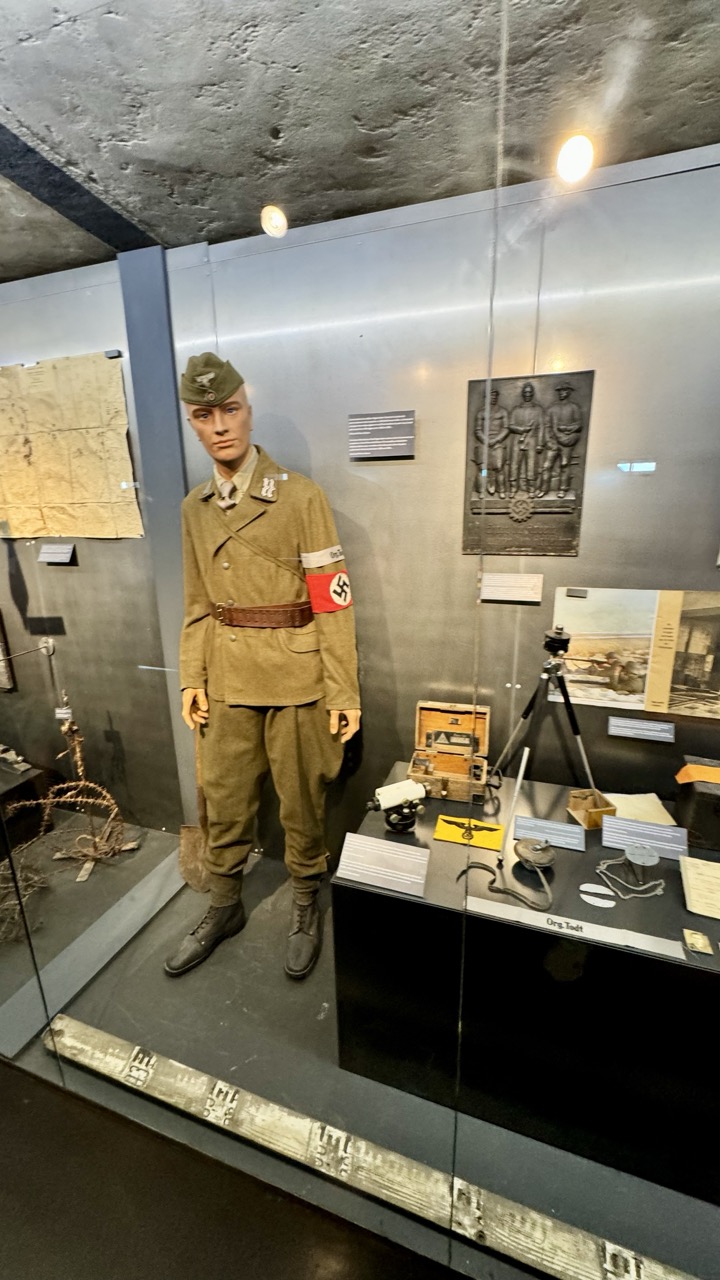

1. Overall Rating (0–10) — 7.0
This photograph effectively captures the solemn gravity of a historical museum exhibit, presenting a meticulously arranged display of World War II-era German military artifacts. The mannequin in uniform serves as a powerful focal point, grounding the viewer in a specific moment of history, while surrounding objects—maps, equipment, and photographs—add layers of context. The lighting, though functional, slightly flattens the emotional weight of the scene, and the glass reflections introduce a subtle distraction, but overall, the image conveys a strong sense of documentation and remembrance.
2. Composition (0–10) — 6.5
The mannequin is centered and well-framed, creating a clear focal point, but the cluttered display and uneven placement of objects on the table to the right introduce visual imbalance. The diagonal line of the wooden beam in the foreground adds depth but also slightly disrupts the composition.
3. Lighting (0–10) — 6.0
The overhead spotlights provide adequate illumination but create harsh reflections on the glass case and cast uneven shadows, particularly on the mannequin’s face. The lighting is practical rather than atmospheric, limiting the mood’s depth.
4. Color & Tone (0–10) — 6.5
The palette is dominated by muted earth tones—olive drab, gray, and black—which reinforce the historical and somber tone. The contrast is moderate, with some areas underexposed and others washed out by glare, but the overall tonal harmony supports the exhibit’s authenticity.
5. Creativity (0–10) — 7.0
The image successfully conveys the narrative of a curated museum display, using juxtaposition of artifacts to tell a story of wartime technology and ideology. The inclusion of personal items like the armband and photographs adds a humanizing element, elevating the exhibit beyond mere display.
6. Technical Quality (0–10) — 7.5
The image is sharp and clear, with well-defined details on the mannequin and surrounding objects. Focus is consistent across the frame, and the resolution is sufficient to distinguish fine text and textures, though some reflections reduce overall clarity.
7. Emotional Impact (0–10) — 7.5
The scene evokes a quiet, reflective tone, prompting contemplation of history and its consequences. The mannequin’s neutral expression and the weight of the artifacts create a sense of solemnity, making the viewer feel the gravity of the past without overt sentimentality.
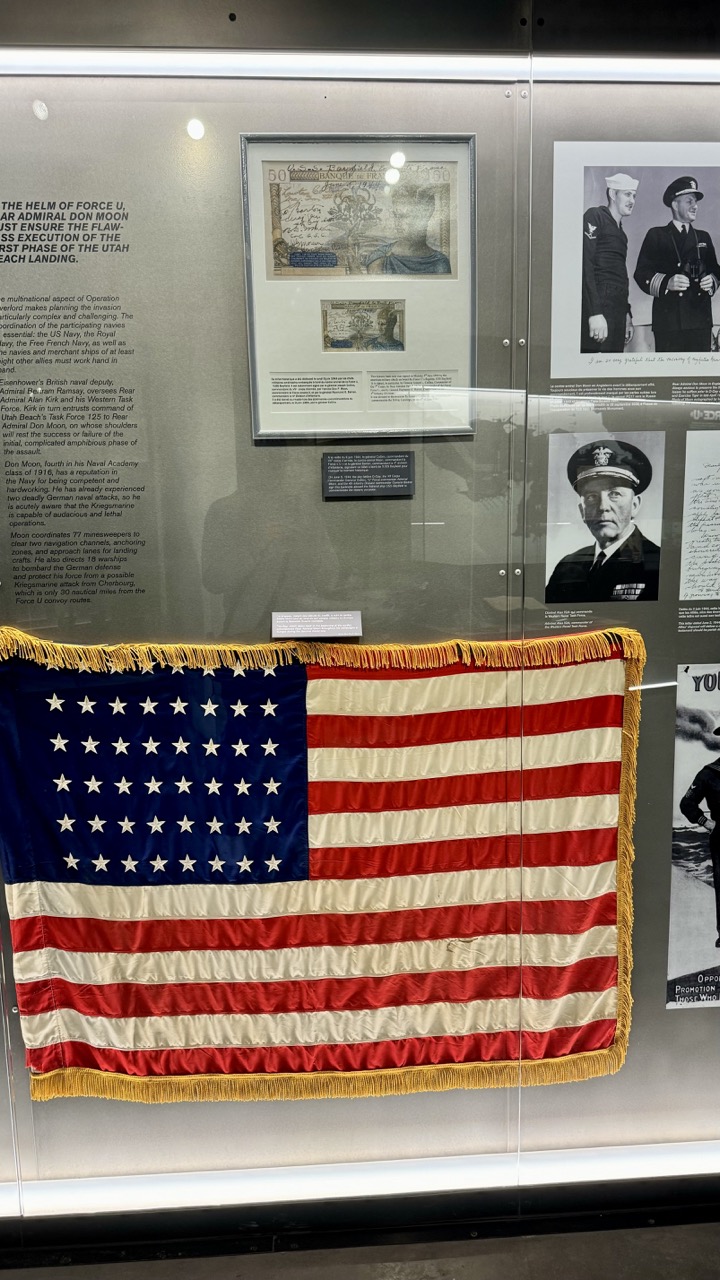

1. Overall Rating (0–10) — 7.0
This photograph captures a solemn and historically resonant museum exhibit, where the American flag takes center stage as a powerful symbol of sacrifice and legacy. The careful arrangement of artifacts—letters, photographs, and official documents—adds depth and narrative weight, grounding the flag in a larger story of military leadership and wartime strategy. While the image is strong in content and intent, the flat lighting and reflective glass slightly diminish its visual impact, keeping it from feeling fully immersive.
2. Composition (0–10) — 7.0
The flag is positioned prominently in the lower half, anchoring the frame, while the surrounding artifacts create a balanced, layered composition. The vertical alignment of text and images guides the eye across the display, though the reflective surface introduces visual distractions.
3. Lighting (0–10) — 6.0
The lighting is functional and even, typical of museum settings, but lacks directional warmth or dramatic contrast. Reflections on the glass reduce clarity in parts of the frame and flatten the scene's depth.
4. Color & Tone (0–10) — 7.5
The American flag’s bold red, white, and blue stand out vividly against the neutral gray of the display case, creating a strong visual contrast. The overall tone is restrained, fitting the serious, commemorative nature of the exhibit.
5. Creativity (0–10) — 7.0
The photograph effectively captures the emotional and historical gravity of the exhibit, using the juxtaposition of flag and archival material to tell a story of leadership and duty. The framing highlights the narrative intent, though it remains largely observational rather than interpretive.
6. Technical Quality (0–10) — 7.5
The image is sharp and clear, with well-defined details in the flag and text. Focus is consistent, and the exposure is balanced, though reflections on the glass slightly compromise the clarity of certain elements.
7. Emotional Impact (0–10) — 7.5
The presence of the flag—symbolic and ceremonial—evokes a sense of reverence and national pride. Paired with the historical artifacts, the scene invites contemplation on leadership, sacrifice, and the weight of history, creating a quietly powerful emotional resonance.


1. Overall Rating (0–10) — 7.0
This photograph captures a compelling museum exhibit that reconstructs a wartime beachhead, blending historical artifacts with a sense of place. The interplay of sand, military equipment, and the distant ocean through the windows evokes the gravity of D-Day operations, grounding the scene in both memory and location. While the composition feels slightly over-crowded and the lighting is functional rather than dramatic, the image succeeds in conveying the scale and solemnity of the historical moment through its immersive staging.
2. Composition (0–10) — 6.0
The frame includes a variety of elements—sandbags, artillery, a landing craft, and a concrete block—that create visual clutter. The diagonal line of sandbags guides the eye through the scene, but the large concrete block in the foreground partially obstructs the view, reducing compositional clarity.
3. Lighting (0–10) — 6.5
Natural light from the expansive windows illuminates the exhibit evenly, preserving detail in the military equipment. However, the bright daylight flattens shadows and tones, diminishing the dramatic atmosphere that would enhance the mood of wartime tension.
4. Color & Tone (0–10) — 6.5
The palette is dominated by muted earth tones—olive green, sand beige, and gray—reinforcing the military theme. The lack of strong color contrast gives the image a subdued, documentary feel, which fits the subject but limits visual vibrancy.
5. Creativity (0–10) — 7.0
The exhibit’s design is creatively effective, using authentic artifacts and environmental cues to recreate a battlefield scene. The inclusion of the ocean view through the windows adds a powerful narrative layer, connecting the past to the present landscape.
6. Technical Quality (0–10) — 7.5
The image is sharp and clear, with good focus across the mid-ground and foreground. The exposure is balanced, capturing details in both shadowed and brightly lit areas without overexposure.
7. Emotional Impact (0–10) — 7.0
The scene evokes a contemplative mood, inviting reflection on sacrifice and history. The presence of a lone visitor in the background subtly underscores the human connection to these artifacts, deepening the emotional resonance.


1. Overall Rating (0–10) — 7.0
This photograph captures a meticulously crafted model of a WWII-era M4 Sherman tank, presented with a sense of historical reverence and technical precision. The model’s fine detailing and authentic markings—like the “H*2” and “Hurricane” stencils—elevate it beyond mere replica, evoking the weight of military history. While the background elements add context, the composition feels slightly cluttered, and the lighting, though functional, doesn’t fully emphasize the tank’s sculptural form.
2. Composition (0–10) — 6.5
The tank is placed diagonally, creating a dynamic angle, but the framing feels slightly off-center and the background clutter—particularly the poster and signage—distracts from the subject’s prominence. A tighter crop would better focus attention on the model’s craftsmanship.
3. Lighting (0–10) — 6.0
The lighting is even and functional, illuminating the tank’s surface details clearly, but it lacks directionality and depth. The flat, ambient light fails to create dramatic shadows or highlights, diminishing the model’s three-dimensional presence.
4. Color & Tone (0–10) — 7.0
The muted olive drab of the tank contrasts well with the neutral gray surface and the black-and-white photograph behind it. The limited palette enhances the historical tone, though the yellow banner adds a slightly jarring pop of color that disrupts the overall harmony.
5. Creativity (0–10) — 7.5
The image successfully blends a model with historical context, using the background artifacts—like the photograph and signage—to tell a layered story. The choice to frame the model within a museum-like setting adds narrative depth, elevating it beyond a simple product shot.
6. Technical Quality (0–10) — 8.0
The model is sharply in focus, with excellent detail visible in the tracks, hull, and decals. The image is clear and well-exposed, though slight reflections on the glass case and minor lens flare detract from the overall polish.
7. Emotional Impact (0–10) — 6.5
The photograph evokes a quiet reverence for military history, with the model serving as a tangible link to the past. However, the lack of dramatic lighting and the busy background prevent a stronger emotional resonance, leaving the viewer with an impression of documentation rather than awe.
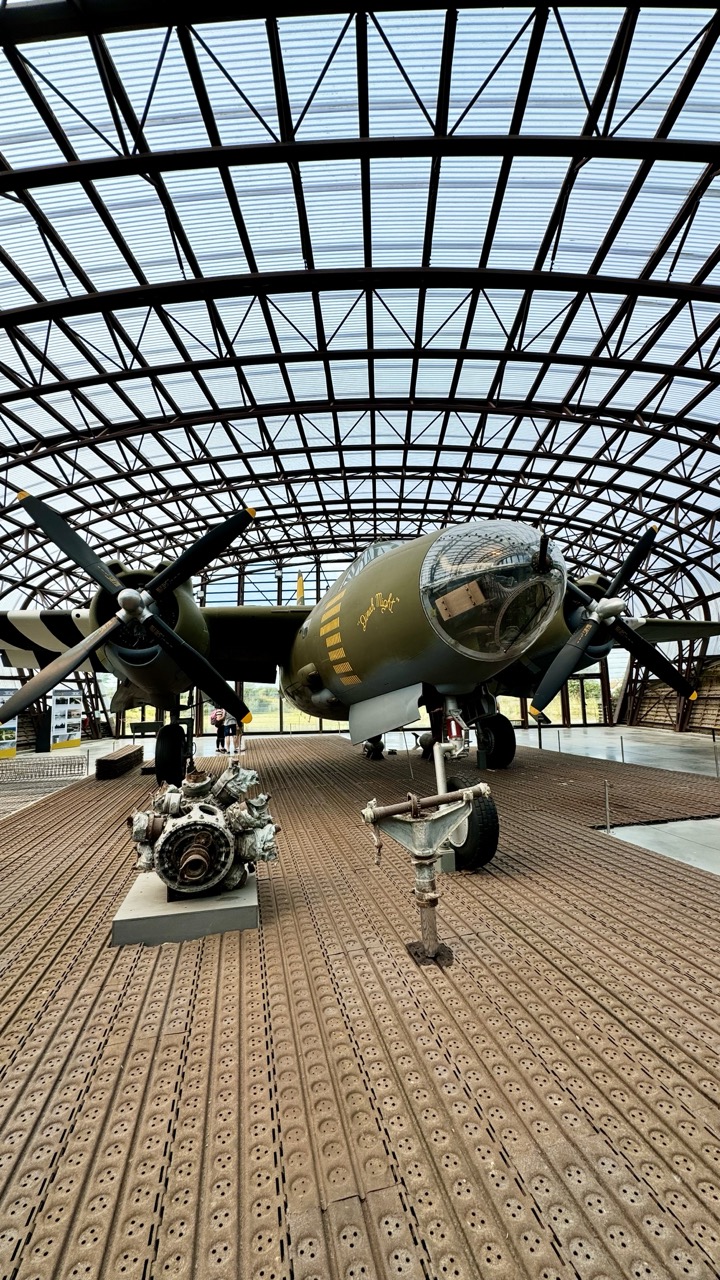

1. Overall Rating (0–10) — 7.0
This photograph captures the grandeur of a vintage military aircraft displayed within a vast, industrial-style hangar, evoking a sense of historical reverence and mechanical majesty. The low-angle perspective amplifies the plane’s imposing presence, while the intricate lattice of the roof structure adds architectural depth and rhythm. Though the composition is strong and the subject compelling, the foreground elements—particularly the engine and landing gear—slightly clutter the visual path, diluting the impact of the aircraft’s central form.
2. Composition (0–10) — 7.5
The low-angle shot creates a dramatic sense of scale, with the aircraft centered and leading the eye toward the structural arch of the hangar. The grid-like floor and roof reinforce symmetry, though the foreground objects disrupt visual flow slightly.
3. Lighting (0–10) — 6.5
Natural light filters evenly through the translucent roof, creating soft, diffused illumination that highlights the aircraft’s contours without harsh shadows. The lighting is functional and even, supporting clarity but lacking the dramatic contrast that could enhance mood.
4. Color & Tone (0–10) — 6.0
The muted olive-green of the aircraft contrasts with the neutral brown of the floor and the dark steel of the structure. The color palette is historically accurate and subdued, reflecting the military context, but lacks vibrancy and tonal richness.
5. Creativity (0–10) — 7.0
The juxtaposition of vintage engineering against modern industrial architecture offers a compelling narrative of time and preservation. The choice of perspective and framing elevates the aircraft beyond mere display, suggesting a story of legacy and endurance.
6. Technical Quality (0–10) — 8.0
Sharp focus across the frame ensures clear detail in both the aircraft and surrounding elements. The image is well-exposed, with no significant noise or distortion, reflecting strong technical execution.
7. Emotional Impact (0–10) — 6.5
The photograph conveys a quiet reverence for history and technological achievement, inviting reflection on the era of flight it represents. The human figures in the background add scale and subtle narrative, but the overall mood remains contemplative rather than deeply moving.
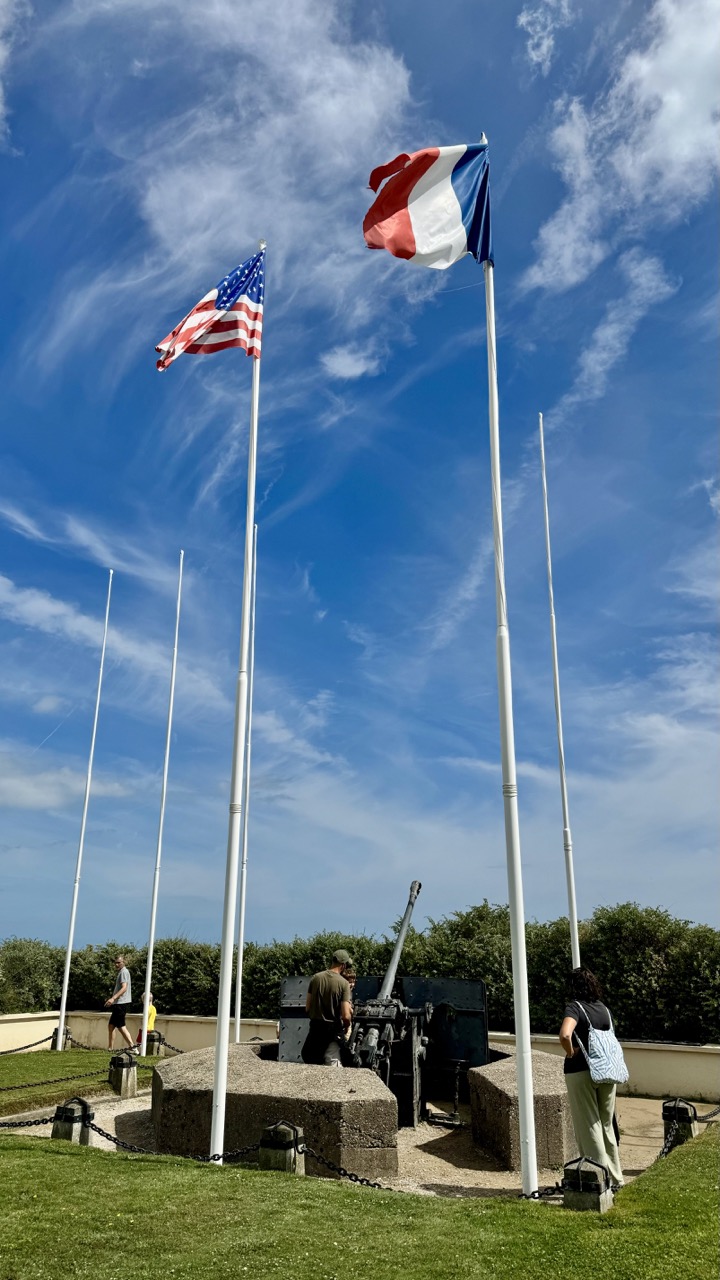

1. Overall Rating (0–10) — 7.0
This photograph captures a poignant moment of historical remembrance under a vast, dynamic sky, where the American and French flags stand as symbols of alliance and shared sacrifice. The low-angle perspective amplifies the flags’ presence, evoking a sense of reverence and grandeur. While the composition is strong and emotionally resonant, the scattered visitors and visible chains slightly disrupt the monument’s solemnity, grounding the image in the present while softening its historical weight.
2. Composition (0–10) — 7.5
The low-angle framing emphasizes the height and prominence of the flagpoles, creating a powerful vertical structure. The placement of the artillery piece and the figures below adds balance and narrative depth, though the multiple poles and foreground elements introduce a slight visual clutter.
3. Lighting (0–10) — 8.0
Bright, natural daylight enhances the vividness of the flags and the rich blue of the sky, with soft clouds adding texture and movement. The sunlight highlights the flags’ fabric and the concrete textures, contributing to a clear, celebratory mood.
4. Color & Tone (0–10) — 8.0
The bold red, white, and blue of the flags contrast strikingly with the deep blue sky and green lawn, creating a vibrant and patriotic palette. The tonal range is well-balanced, with natural saturation that enhances the scene’s emotional impact.
5. Creativity (0–10) — 7.0
The image thoughtfully juxtaposes historical significance with contemporary visitors, suggesting continuity and remembrance. The choice of perspective and focus on the flags imbues the scene with symbolic weight, though the approach remains grounded in documentary realism.
6. Technical Quality (0–10) — 8.0
Sharp focus, clean detail, and accurate exposure contribute to a technically strong image. The depth of field is appropriate, keeping both the foreground and background elements clearly visible.
7. Emotional Impact (0–10) — 7.5
The image evokes a sense of respect and solemn pride, particularly through the visual prominence of the flags and the open sky. The presence of people invites reflection on shared history, creating a quiet connection between past and present.
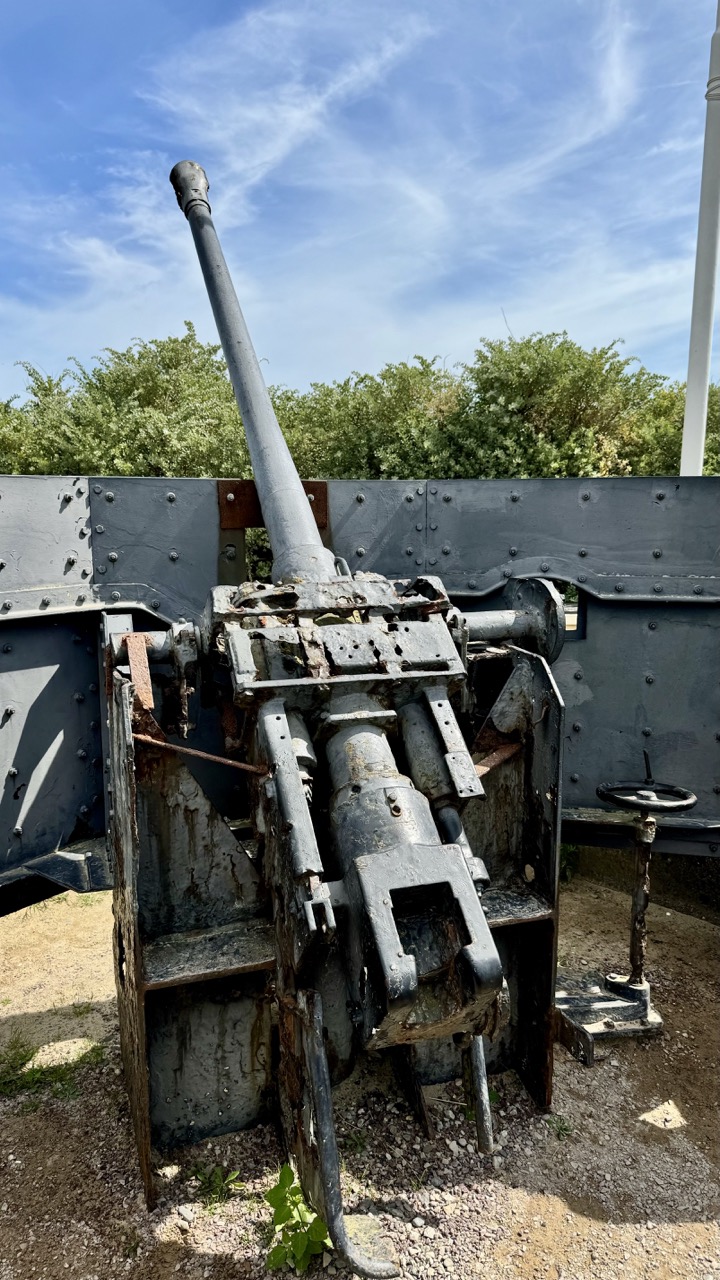

1. Overall Rating (0–10) — 7.0
This photograph captures a weathered artillery piece under a bright blue sky, evoking a quiet tension between past conflict and present tranquility. The juxtaposition of the rusted, battle-scarred gun against the serene backdrop of green trees and wispy clouds creates a contemplative mood. While the image effectively conveys the weight of history, its straightforward presentation and slightly cluttered foreground limit its visual impact.
2. Composition (0–10) — 6.5
The cannon is centered but slightly off-kilter, with the vertical barrel drawing the eye upward. The background foliage and metal structure create a layered frame, though the ground clutter and uneven framing detract from balance.
3. Lighting (0–10) — 7.0
Natural daylight illuminates the scene evenly, enhancing texture and detail on the metal surface. The contrast between light and shadow emphasizes the cannon’s aged form, while the bright sky adds depth and clarity.
4. Color & Tone (0–10) — 6.5
The palette is dominated by muted grays and earth tones, punctuated by the blue sky and green foliage. The tones feel authentic and subdued, reinforcing the historical context, though a touch more vibrancy could elevate the image’s visual appeal.
5. Creativity (0–10) — 6.0
The concept is grounded in historical documentation, with a focus on realism rather than artistic interpretation. The composition tells a story of decay and endurance, but lacks a distinctive or imaginative angle.
6. Technical Quality (0–10) — 7.5
The image is sharp and well-focused, with clear detail visible in the rust, bolts, and metalwork. The exposure is well-managed, with no harsh overexposed areas or lost shadows.
7. Emotional Impact (0–10) — 6.5
The photograph evokes a sense of solemn reflection, inviting the viewer to consider the legacy of war. The juxtaposition of destruction and peace resonates, though the emotional weight is held back by the image’s straightforward presentation.
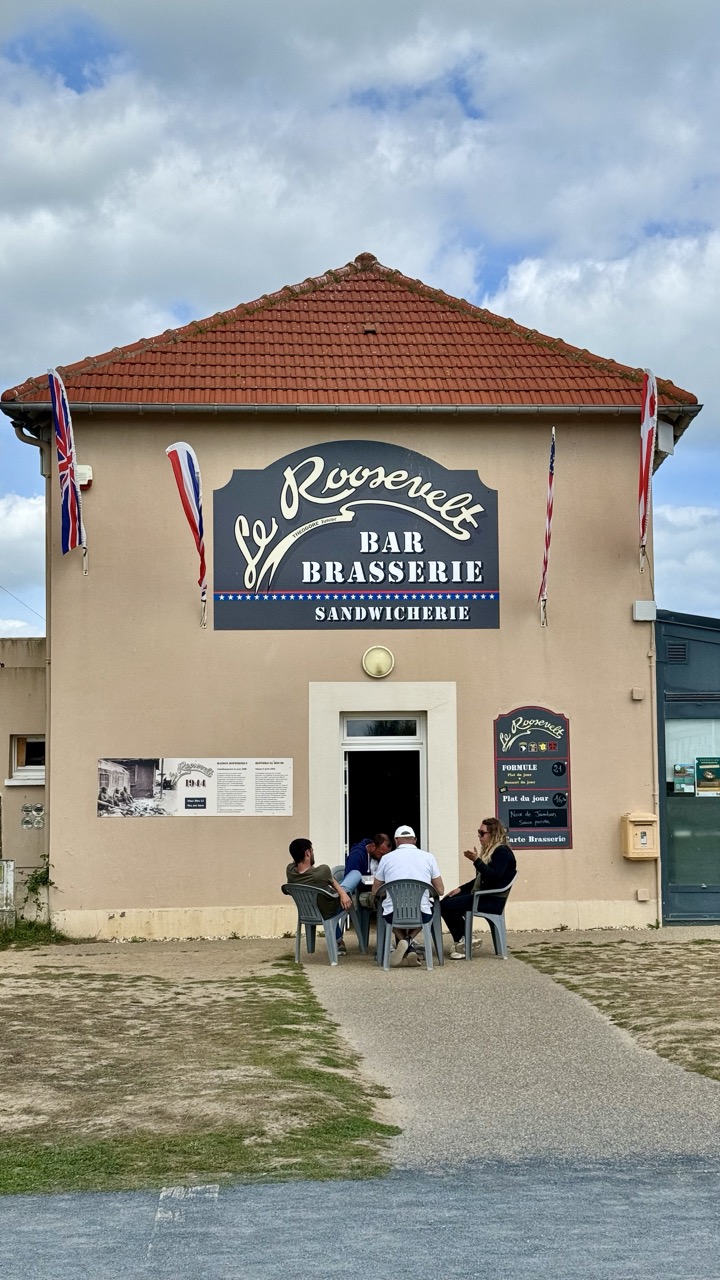

1. Overall Rating (0–10) — 6.0
This photograph captures a quiet, everyday moment outside a modest French brasserie, evoking a sense of casual community and historical charm. The building’s signage and patriotic flags add narrative depth, while the relaxed gathering of patrons grounds the scene in authenticity. However, the composition feels slightly cluttered and unbalanced, and the lighting lacks the warmth needed to elevate the mood, giving the image a more documentary than artistic quality.
2. Composition (0–10) — 5.5
The central placement of the building provides a strong focal point, but the wide framing dilutes the impact, leaving too much empty ground and sky. The group of people, though central, appears small and slightly off-kilter, diminishing their visual weight.
3. Lighting (0–10) — 6.0
Natural daylight is evenly distributed, but the overcast sky creates flat, diffused lighting that softens shadows and reduces visual texture. While it allows for clear detail, it lacks the dynamic contrast that could bring depth to the scene.
4. Color & Tone (0–10) — 6.5
The palette is restrained, dominated by muted beige, red, and gray, with the blue of the sign and sky offering subtle contrast. The colors feel authentic but underwhelming, with a slight cool cast that tempers the warmth of the setting.
5. Creativity (0–10) — 6.5
The image succeeds in capturing a slice of life with a touch of historical storytelling through the flags and signage. The juxtaposition of American and British symbols with a French brasserie suggests a narrative worth exploring, though the execution remains more observational than inventive.
6. Technical Quality (0–10) — 7.0
The image is sharp and well-focused, with clean details visible in the signage and architectural elements. The exposure is balanced, and there is no noticeable noise or distortion.
7. Emotional Impact (0–10) — 5.5
The photograph conveys a quiet, unassuming moment of social connection, but the emotional resonance is restrained by the flat lighting and impersonal framing. It invites curiosity about the place and its history, but doesn’t deeply engage the viewer.


1. Overall Rating (0–10) — 7.0
This photograph captures the cozy, eclectic charm of a rustic café, where layers of memorabilia and warm lighting create a sense of lived-in history. The blend of French and American flags, along with the handwritten bar top and vintage decor, speaks to a place rich in cultural exchange and personal stories. While the image feels candid and authentic, the slightly cluttered composition and uneven lighting prevent it from achieving a more polished visual harmony.
2. Composition (0–10) — 6.5
The low-angle perspective emphasizes the wooden beams and hanging flag, creating a sense of immersion. However, the crowded bar area and scattered elements compete for attention, leading to a slightly unbalanced feel. A tighter crop or more deliberate framing could better guide the viewer’s eye.
3. Lighting (0–10) — 6.0
Warm, ambient lighting from the overhead pendant lamp enhances the inviting atmosphere, but the mix of artificial light and natural light from the doorway creates uneven exposure. Some areas are brightly lit while others fall into shadow, reducing overall cohesion.
4. Color & Tone (0–10) — 6.5
The palette is dominated by earthy browns and the bold red, white, and blue of the flags, creating visual interest. However, the color temperature is inconsistent, with the yellow lamp casting a strong warm glow that clashes slightly with the cooler tones in the background.
5. Creativity (0–10) — 7.5
The photograph successfully captures a unique, character-filled space with a strong narrative potential. The layering of flags, photos, and memorabilia tells a story of travel and connection, making it more than just a snapshot—it’s a cultural portrait.
6. Technical Quality (0–10) — 7.0
The image is sharp and detailed, particularly in the foreground. Focus is well-managed, and the depth of field allows for both subject clarity and environmental context. The slight overexposure in the doorway and underexposure in the back corner are minor technical flaws.
7. Emotional Impact (0–10) — 7.0
The photograph evokes a sense of nostalgia and warmth, inviting the viewer to imagine the conversations and memories made in this space. The human presence, combined with the personal touches, gives it a quiet emotional resonance that feels genuine and welcoming.
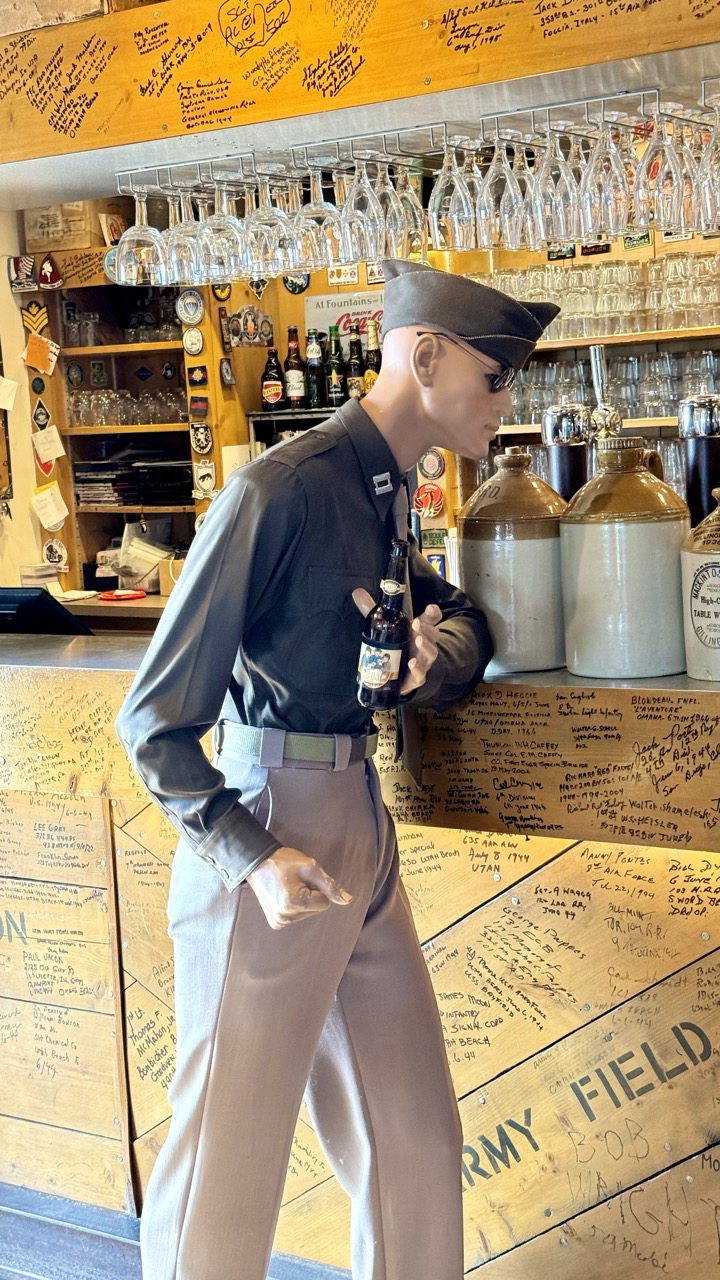

1. Overall Rating (0–10) — 7.0
This photograph captures a striking juxtaposition of military formality and casual bar culture, centered on a mannequin dressed in a military uniform holding a beer bottle. The setting, rich with handwritten inscriptions and vintage bar decor, evokes a sense of history and storytelling, while the mannequin’s pose adds a layer of irony and humor. Though the scene is visually dense and slightly chaotic, the image succeeds in conveying a narrative about memory, ritual, and the blending of solemnity with everyday life.
2. Composition (0–10) — 6.5
The mannequin is well-placed as the central subject, but the cluttered background and overlapping elements—such as the handwritten walls, hanging glassware, and stacked jugs—create visual distraction. A tighter crop would enhance focus, though the current framing effectively communicates the environment’s layered history.
3. Lighting (0–10) — 6.0
Natural light from the left side illuminates the mannequin clearly, but the overall lighting is flat and uneven, with some areas underexposed and others washed out. The fluorescent glow of the bar contributes to a sterile atmosphere that contrasts with the nostalgic subject matter.
4. Color & Tone (0–10) — 6.5
The palette is dominated by earthy browns, muted greens, and grays, which harmonize with the military and vintage themes. The dark beer bottle provides a strong visual anchor, while the scattered handwriting adds textural contrast. A touch more warmth could enhance the inviting quality of the space.
5. Creativity (0–10) — 7.5
The image is highly original in its conceptual framing—the military mannequin in a bar setting suggests themes of remembrance, camaraderie, and the normalization of military life. The handwritten walls further deepen the sense of personal history, making the scene feel both curated and authentic.
6. Technical Quality (0–10) — 7.0
The photograph is sharp and clear, with good detail in the mannequin’s uniform and the surrounding objects. Focus is consistent, and the depth of field is adequate, though some elements in the background appear slightly soft.
7. Emotional Impact (0–10) — 7.0
The image evokes a quiet sense of nostalgia and reflection, inviting the viewer to consider the stories behind the names on the wall and the symbolism of the uniform. The juxtaposition of the mannequin’s solemn posture with the casual act of holding a beer creates a poignant, almost melancholic resonance.
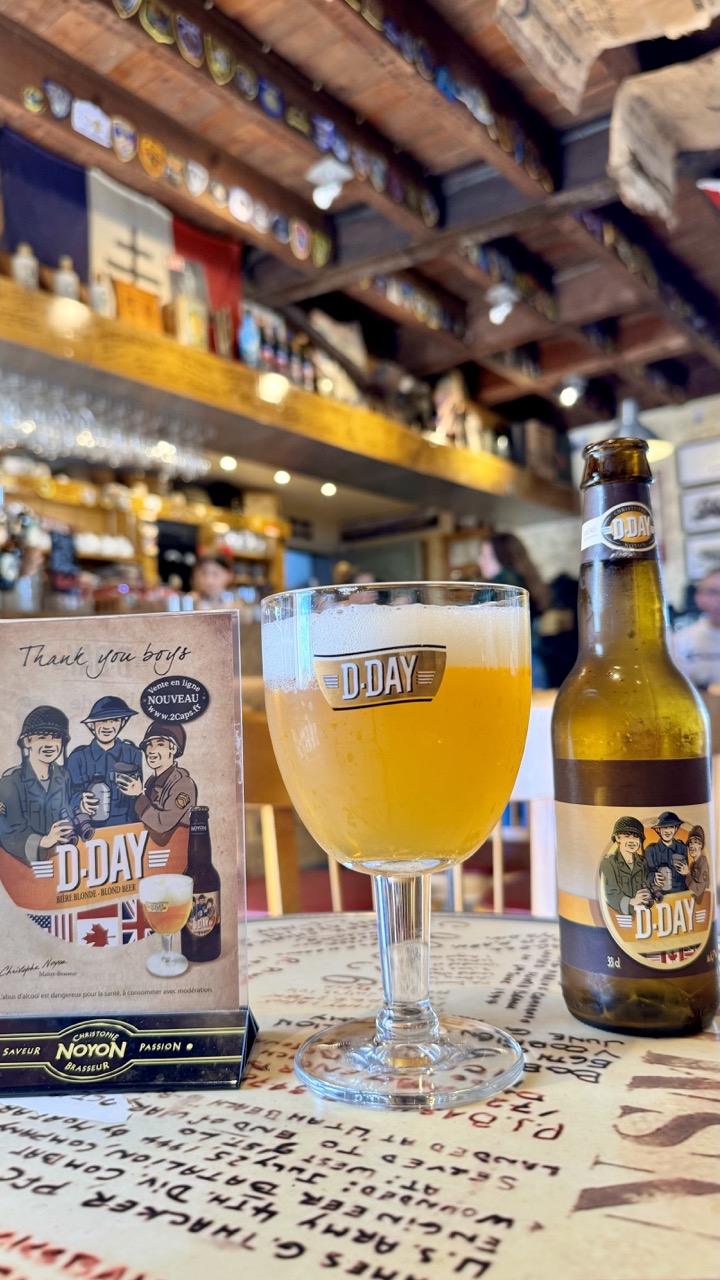

1. Overall Rating (0–10) — 7.0
This photograph captures the cozy, nostalgic atmosphere of a Belgian beer bar with a strong sense of place and storytelling. The D-Day beer branding and military-themed decor create a thematic cohesion that feels both intentional and immersive. While the scene is rich with detail, the slightly cluttered foreground and uneven lighting prevent it from achieving a more refined visual balance.
2. Composition (0–10) — 6.5
The subject is well-placed in the foreground, drawing attention to the beer and branding, but the cluttered table and background elements create visual noise. A tighter crop would enhance focus on the central narrative.
3. Lighting (0–10) — 6.0
Warm ambient lighting enhances the inviting mood, but the overhead lights create harsh reflections on the glass and bottle, slightly diminishing the clarity of the scene.
4. Color & Tone (0–10) — 7.0
The golden hue of the beer complements the warm wood tones and earthy labels, creating a cohesive, inviting palette. However, the overall color balance leans slightly yellow, reducing the vibrancy of other elements.
5. Creativity (0–10) — 7.5
The image successfully blends product placement with environmental storytelling, using the D-Day theme and historical decor to evoke a sense of place and time. The combination of real-world authenticity and deliberate branding makes it both engaging and distinctive.
6. Technical Quality (0–10) — 7.5
The focus is sharp on the glass and bottle, with clear detail in the labels and table text. The depth of field is appropriate, though some background elements are slightly overexposed.
7. Emotional Impact (0–10) — 7.0
The photograph evokes a sense of warmth, nostalgia, and quiet celebration—perfectly capturing the spirit of a traditional European brasserie. The personal touch of the “Thank you boys” card adds a subtle emotional layer, inviting the viewer to connect with the story behind the beer.
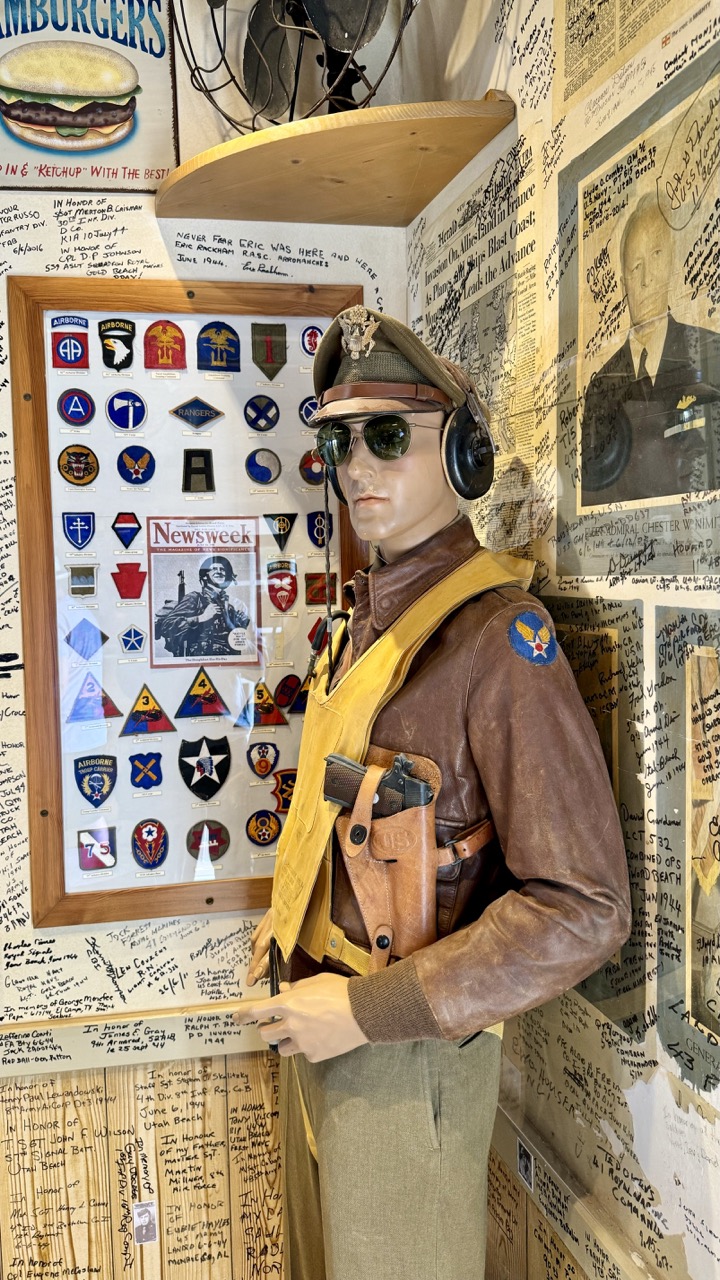

1. Overall Rating (0–10) — 7.0
This photograph captures a compelling blend of historical homage and intimate storytelling, centered on a mannequin dressed in authentic WWII-era flight gear. The layered textures—handwritten tributes, military patches, and vintage memorabilia—create a rich, tactile narrative that feels both personal and reverent. While the visual density risks overwhelming the viewer, the composition ultimately succeeds in conveying a deep sense of remembrance, with the mannequin serving as a solemn guardian of collective memory.
2. Composition (0–10) — 7.0
The mannequin is well-placed as a focal point, with the framed patch display and handwritten walls forming a layered backdrop. The slight asymmetry and overlapping elements lend a candid, museum-like authenticity, though the cluttered environment slightly detracts from visual clarity.
3. Lighting (0–10) — 6.5
Even, ambient indoor lighting illuminates the scene without harsh shadows, allowing the details of the mannequin and surrounding memorabilia to be clearly visible. The lighting is functional rather than dramatic, which suits the documentary tone but limits atmospheric depth.
4. Color & Tone (0–10) — 7.5
The palette is grounded in earthy browns, muted yellows, and faded blues, evoking the age and solemnity of the era. The contrast between the vibrant patches and the weathered wall text creates visual interest, with the greens of the aviator goggles offering a subtle pop of color.
5. Creativity (0–10) — 8.0
The image is highly creative in its use of layered storytelling—military insignia, personal dedications, and period-specific artifacts converge to form a powerful tribute. The integration of personal handwriting into the background adds emotional resonance, transforming the scene from a display into a living memorial.
6. Technical Quality (0–10) — 7.5
The image is sharp and well-focused, with clear detail in the mannequin’s uniform, the leather gear, and the text on the walls. The depth of field is appropriate, keeping both the subject and the background legible, though slight overexposure in the top-left area slightly softens the edges.
7. Emotional Impact (0–10) — 8.5
The photograph evokes a profound sense of reverence and nostalgia, drawing the viewer into a space where history is preserved through memory and personal connection. The handwritten tributes, in particular, create a poignant emotional link, transforming the scene into a quiet monument to service and sacrifice.


1. Overall Rating (0–10) — 6.0
This photograph captures a quiet, contemplative moment at the edge of the sea, where a lone figure wades into the water under a vast, open sky. The scene feels peaceful and introspective, evoking a sense of solitude and connection with nature. While the composition and mood are strong, the image lacks visual dynamism, and the muted tones and distant subject slightly diminish its emotional pull.
2. Composition (0–10) — 6.5
The subject is placed off-center, creating a sense of space and balance with the expansive water and sky. The horizontal lines of the horizon and pier guide the eye across the frame, though the foreground seaweed and the distant boy feel slightly disconnected, reducing compositional cohesion.
3. Lighting (0–10) — 6.0
Soft, diffused daylight evenly illuminates the scene, minimizing harsh shadows and creating a calm, serene atmosphere. The light is consistent but lacks warmth or drama, contributing to the image’s subdued tone.
4. Color & Tone (0–10) — 5.5
The palette is dominated by muted blues and grays, with a small splash of orange from the boy’s shirt providing a subtle focal point. While harmonious, the overall tone is flat and underexposed, limiting visual richness and depth.
5. Creativity (0–10) — 6.0
The image captures a simple, everyday moment with quiet dignity, emphasizing atmosphere over spectacle. The choice to frame the scene with the pier and marker adds narrative context, but the execution feels more observational than artistically bold.
6. Technical Quality (0–10) — 7.0
The image is sharp and clear, with good focus on the subject and background. The exposure is balanced, though the low contrast and slight lack of vibrancy suggest room for post-processing refinement.
7. Emotional Impact (0–10) — 5.5
The photograph evokes a sense of stillness and introspection, but the emotional resonance is tempered by the distance between the viewer and the subject. It invites reflection but does not fully engage on a deeper level.


1. Overall Rating (0–10) — 7.0
This photograph captures a striking juxtaposition of industrial decay and monumental form, with the weathered concrete dome and slender spire evoking both historical weight and quiet resilience. The low-angle perspective amplifies the structure’s imposing presence, while the dynamic sky adds a sense of motion and timelessness. Though the image is compelling in its raw, unembellished realism, it could benefit from more refined tonal contrast to fully realize its dramatic potential.
2. Composition (0–10) — 7.5
The low-angle framing emphasizes the monument’s scale and dominance, with the curved dome leading the eye upward toward the spire. The diagonal shadow in the foreground adds depth, while the sky’s scattered clouds balance the composition and provide visual rhythm.
3. Lighting (0–10) — 7.0
Natural daylight illuminates the scene evenly, highlighting the texture and wear of the concrete. The interplay of light and shadow across the dome’s surface adds dimension, though the overall exposure is slightly flat, reducing the atmospheric impact.
4. Color & Tone (0–10) — 6.5
The palette is largely monochromatic, dominated by grays and blues, which reinforces the industrial tone. While the blue sky provides a subtle contrast, the lack of vibrancy in the concrete tones limits the image’s emotional resonance.
5. Creativity (0–10) — 7.0
The image presents a strong conceptual vision—blending architectural history with natural elements—through a bold, grounded perspective. The choice to frame the monument in this way suggests an intentional focus on endurance and memory.
6. Technical Quality (0–10) — 7.5
The image is sharp and well-focused, with clear detail visible in the concrete’s surface and texture. The wide-angle perspective is controlled, avoiding excessive distortion.
7. Emotional Impact (0–10) — 6.5
The photograph conveys a contemplative mood, inviting reflection on time, war, and remembrance. While the emotional weight is present, the lack of dramatic lighting and color subtlety keeps the viewer at a slight remove from deeper connection.
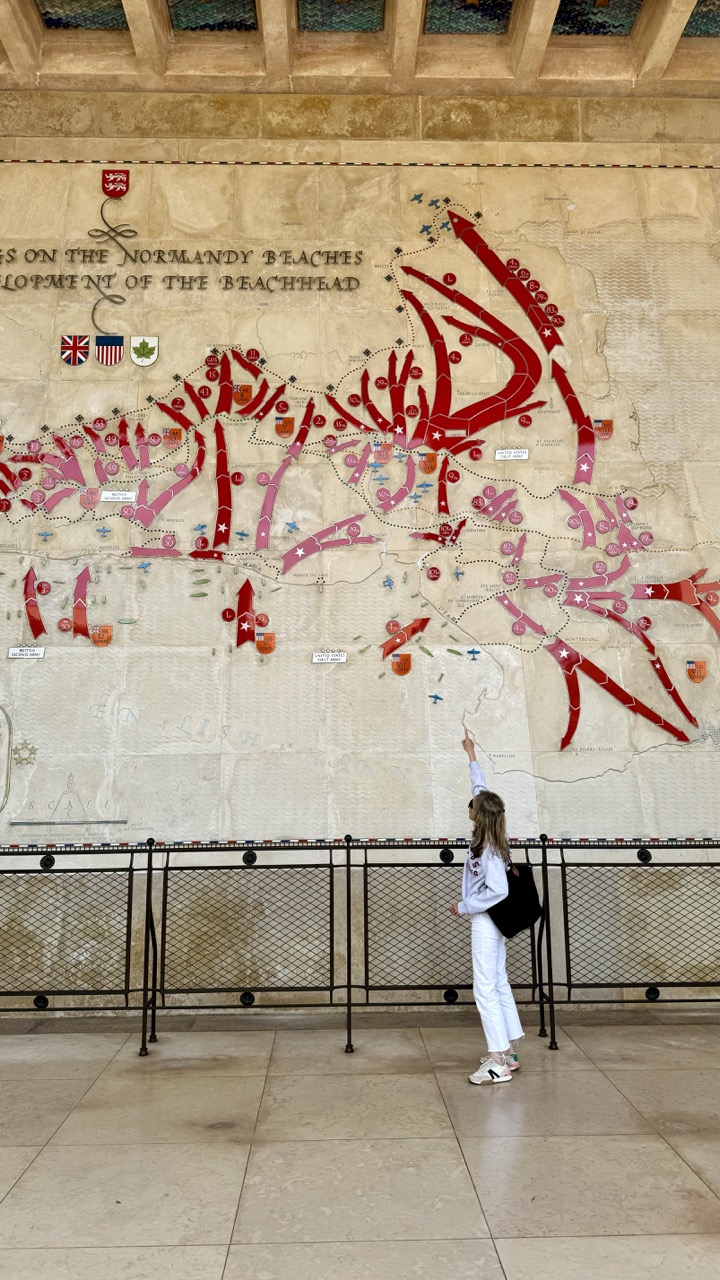

1. Overall Rating (0–10) — 7.0
This photograph captures a contemplative moment of historical reflection, where a visitor stands before a monumental map detailing the D-Day landings. The scale of the wall art contrasts with the solitary figure, emphasizing the weight of the event. While the image effectively conveys a sense of reverence and education, the composition is slightly weakened by a lack of dynamic lighting and a somewhat flat perspective.
2. Composition (0–10) — 6.5
The subject is placed off-center, creating a sense of balance with the expansive map behind her. However, the wide framing dilutes focus, and the foreground railing introduces a visual barrier that slightly disrupts the viewer's connection to the scene.
3. Lighting (0–10) — 6.0
The lighting is even and functional, typical of an indoor museum space, but it lacks depth and shadow, resulting in a flat, neutral tone that does little to highlight the texture or significance of the mural.
4. Color & Tone (0–10) — 6.5
The muted beige of the wall provides a neutral backdrop, allowing the red and pink military symbols to stand out. The woman’s white outfit blends subtly with the environment, while the reds carry a sense of urgency and gravity, though the overall palette remains restrained.
5. Creativity (0–10) — 7.0
The juxtaposition of a modern visitor with a historical monument creates a narrative of memory and legacy. The photograph captures not just a place, but a moment of personal engagement with history—suggesting a story beyond the frame.
6. Technical Quality (0–10) — 7.5
The image is sharp and well-focused, with clear detail visible in the map’s text and symbols. The camera’s perspective is stable, and the exposure is well-balanced, though the lack of lighting drama holds back visual impact.
7. Emotional Impact (0–10) — 7.5
There is a quiet solemnity in the scene—this is a moment of learning, of connection to a pivotal past. The viewer is invited to consider the scale of sacrifice and the enduring nature of historical memory, making the image emotionally resonant despite its subdued presentation.
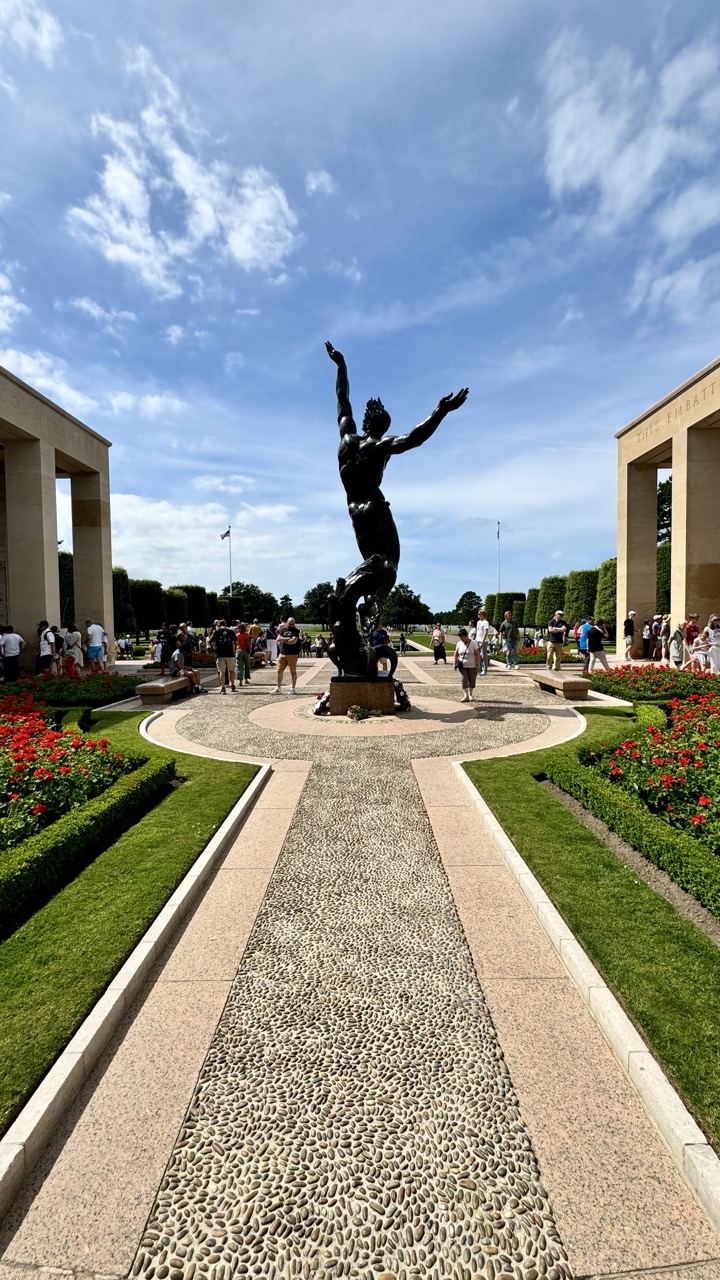

1. Overall Rating (0–10) — 8.0
This photograph captures the solemn grandeur of a war memorial with striking clarity and emotional resonance. The symmetrical composition draws the eye toward the central statue, a powerful symbol of sacrifice, while the vibrant flowers and expansive sky lend both contrast and hope. Though the presence of visitors adds a human element, it doesn’t detract from the monument’s dignity—instead, it reinforces the site’s ongoing significance as a place of remembrance.
2. Composition (0–10) — 9.0
The strong leading lines of the pebble pathway and flanking hedges guide the viewer’s gaze directly to the statue, creating a balanced and purposeful frame. The symmetry enhances the sense of order and reverence, with the architecture and landscaping reinforcing the monument’s solemnity.
3. Lighting (0–10) — 8.5
Natural daylight illuminates the scene evenly, with soft shadows that enhance depth without overpowering the details. The bright blue sky and scattered clouds create a luminous backdrop, adding drama while preserving the monument’s integrity.
4. Color & Tone (0–10) — 8.0
The contrast between the deep black of the statue, the lush green of the grass, and the vivid red of the flowers creates a dynamic yet harmonious palette. The warm tones of the stone and the cool sky strike a balance between solemnity and life.
5. Creativity (0–10) — 7.5
The image is grounded in a classic, documentary-style approach, but the thoughtful framing and use of symmetry elevate it beyond mere documentation. It captures both the scale of the memorial and the quiet human presence that gives it meaning.
6. Technical Quality (0–10) — 9.0
Sharp focus, excellent clarity, and well-balanced exposure ensure that every element—from the texture of the pebbles to the sculptural details—is rendered with precision. The camera’s perspective is well-chosen, capturing both the monument and its environment with clarity.
7. Emotional Impact (0–10) — 9.0
The image evokes a profound sense of reverence and reflection, underscored by the monument’s powerful form and the quiet dignity of the surrounding space. The presence of visitors reminds us that memory is not static—it is lived, honored, and passed on.
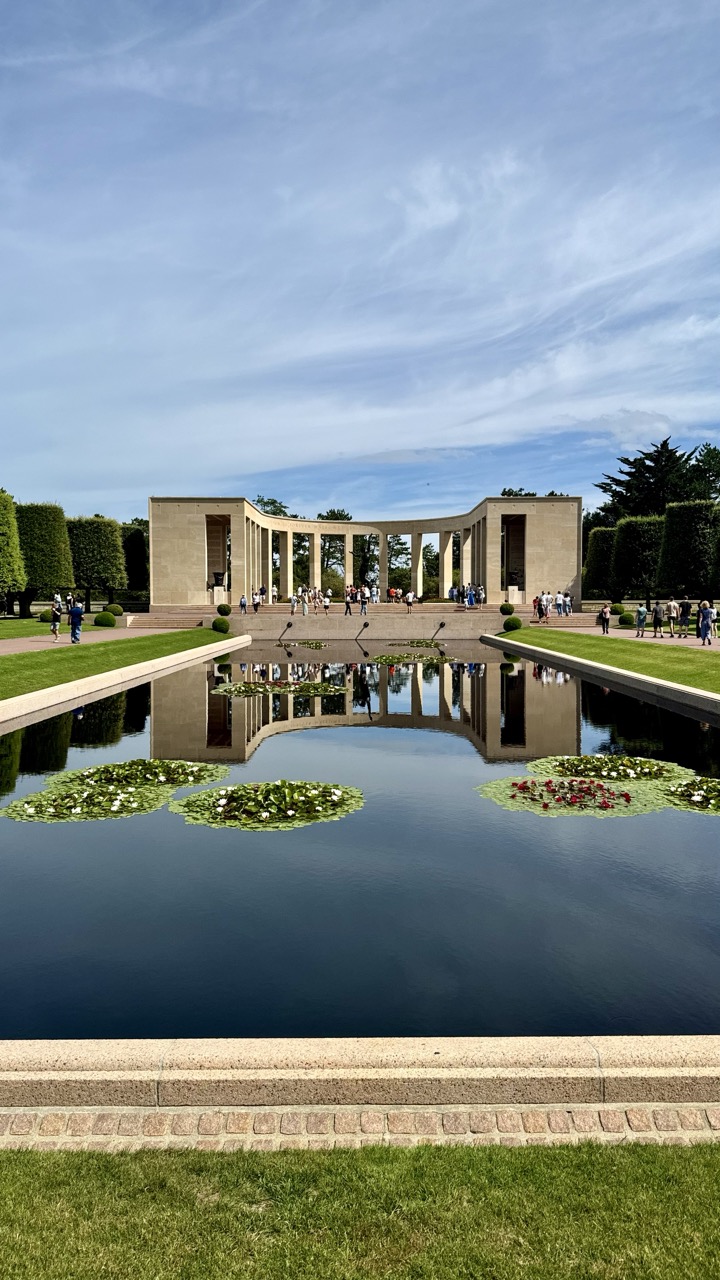

1. Overall Rating (0–10) — 8.0
This photograph captures the solemn grandeur of a war memorial with striking symmetry and emotional weight. The reflective pool creates a powerful mirror of the structure, doubling its presence and evoking a sense of peace and remembrance. While the composition is strong and the subject inherently meaningful, the presence of visitors adds a subtle human element that, while grounding, slightly disrupts the monument’s timeless stillness.
2. Composition (0–10) — 8.5
The symmetrical framing centers the memorial perfectly, with the pool leading the eye toward the structure. The low angle enhances the monument’s scale, while the manicured hedges and walkways guide the viewer’s gaze naturally, creating a balanced and harmonious scene.
3. Lighting (0–10) — 8.0
Soft, diffused daylight enhances the calm atmosphere, with gentle shadows that add depth without overpowering the scene. The sky’s pale blue and wispy clouds contribute to a serene mood, while the water’s surface captures the light with clarity and quiet reflection.
4. Color & Tone (0–10) — 7.5
The palette is composed of restrained earth tones—beige stone, deep green lawn, and the dark, reflective water—creating a somber and cohesive look. The white and red flowers on the lily pads offer subtle color accents that draw attention without disrupting the overall harmony.
5. Creativity (0–10) — 8.0
The photographer leverages symmetry and reflection to transform a commemorative site into a visually poetic image. The juxtaposition of still water and moving visitors introduces a narrative layer, suggesting continuity between past and present.
6. Technical Quality (0–10) — 9.0
Sharp focus and clean detail are evident throughout, from the texture of the stone to the delicate lily pads. The exposure is well-balanced, with no harsh highlights or crushed shadows, allowing the scene to feel both vivid and natural.
7. Emotional Impact (0–10) — 8.5
The image conveys reverence and contemplation, inviting viewers to pause and reflect. The quiet dignity of the space, amplified by the symmetry and stillness, resonates deeply, making the memorial feel both monumental and intimately personal.


1. Overall Rating (0–10) — 8.0
This photograph captures the solemn grandeur of a war memorial with quiet reverence, where architectural symmetry and symbolic elements converge to evoke a sense of enduring sacrifice. The composition draws the eye naturally to the central inscription and the luminous stained-glass window, while the flags on either side reinforce the collective remembrance of allied nations. Though the scene is rich in meaning, the lighting’s cool neutrality slightly dampens the emotional weight, keeping the image more observational than transcendent.
2. Composition (0–10) — 9.0
The symmetrical arrangement of flags and the central focus on the memorial altar create a balanced, reverent composition. The vertical window draws the eye upward, while the reflective floor extends the space, enhancing the sense of solemnity and depth.
3. Lighting (0–10) — 7.0
Natural light from the window illuminates the space evenly, highlighting the inscription and mosaic above. However, the cool, diffused quality of the light, while appropriate for the subject, lacks the warmth or dramatic contrast that could heighten the emotional resonance.
4. Color & Tone (0–10) — 7.5
The muted tones of the stone and marble are complemented by the bold red, white, and blue of the flags, creating a restrained yet powerful color palette. The black marble of the altar provides strong contrast, grounding the composition and emphasizing the inscription.
5. Creativity (0–10) — 8.0
The image successfully conveys a narrative of unity and remembrance through its careful arrangement of symbolic elements. The inclusion of the mosaic and cross within the window adds a spiritual dimension, elevating the scene beyond a simple documentation into a contemplative statement.
6. Technical Quality (0–10) — 8.5
The photograph is sharp and well-focused, with clear details in the text, flags, and architectural textures. The exposure is balanced, and the camera angle captures the full scope of the space without distortion.
7. Emotional Impact (0–10) — 8.5
The image evokes a profound sense of reverence and reflection, drawing the viewer into a moment of quiet remembrance. The combination of light, symmetry, and symbolic objects creates a powerful emotional resonance, inviting contemplation on sacrifice and unity.
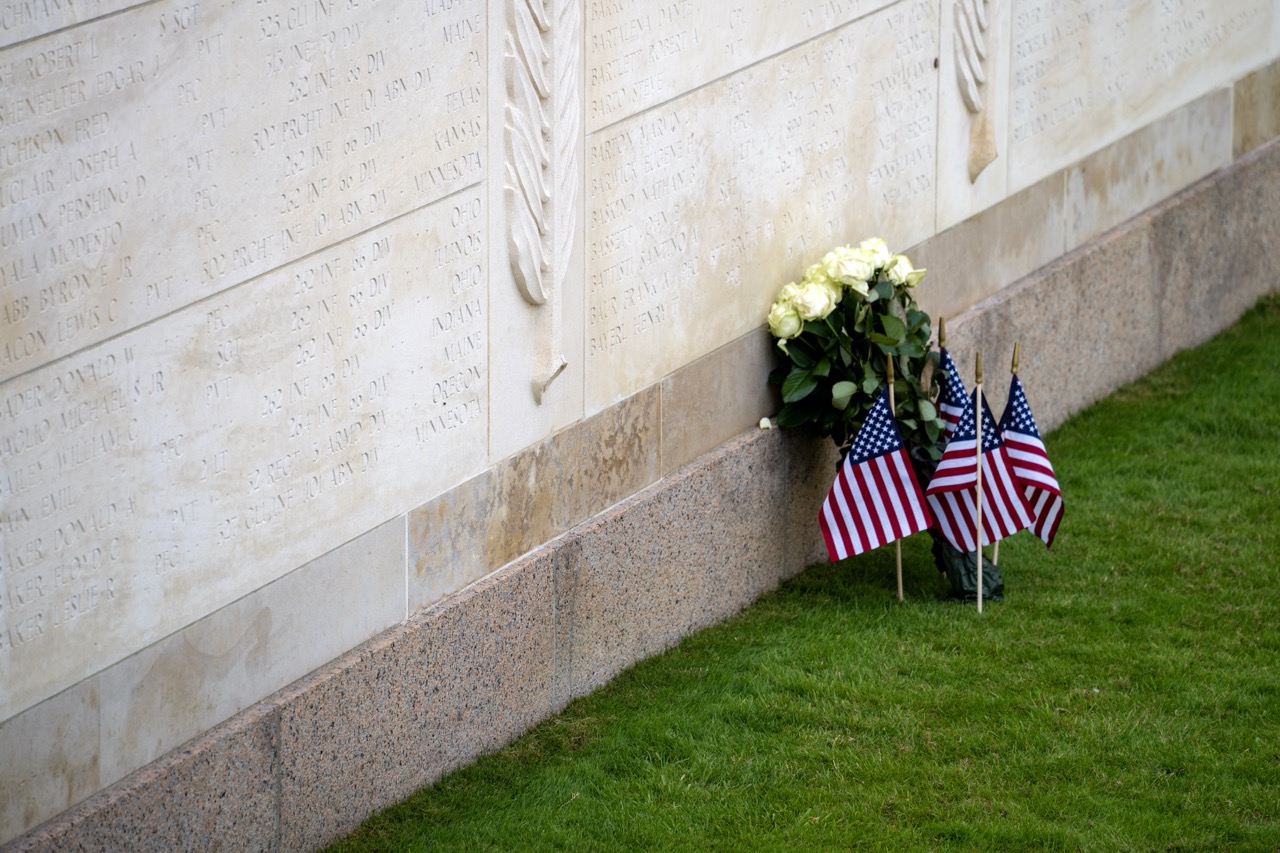

1. Overall Rating (0–10) — 8.0
This photograph captures a solemn and respectful tribute at a war memorial, where the quiet dignity of remembrance is powerfully conveyed. The juxtaposition of the enduring stone wall, inscribed with names, against the fresh flowers and flags creates a poignant moment of personal homage. While the image is emotionally resonant and compositionally strong, its simplicity—though appropriate—limits its visual dynamism.
2. Composition (0–10) — 7.5
The low-angle perspective draws the viewer into the scene, emphasizing the intimacy of the tribute. The diagonal line of the wall guides the eye from the engraved names to the flowers and flags, creating a natural visual path. The placement of the bouquet and flags off-center adds balance without disrupting the solemn mood.
3. Lighting (0–10) — 8.0
Soft, diffused natural light enhances the texture of the stone and the delicate petals of the flowers, lending a gentle, reverent tone. The even lighting avoids harsh shadows and preserves the quiet atmosphere, allowing the emotional weight of the scene to unfold naturally.
4. Color & Tone (0–10) — 8.0
The muted tones of the stone and green grass provide a neutral backdrop that allows the red, white, and blue of the flags to stand out with symbolic clarity. The pale yellow of the roses adds a soft warmth, contrasting with the coolness of the stone and reinforcing the theme of life and remembrance.
5. Creativity (0–10) — 7.5
The image is not overtly stylized, but its strength lies in its conceptual clarity—honoring the individual through a personal gesture against the collective memory. The simplicity of the arrangement enhances the narrative, making the act of remembrance feel both universal and deeply personal.
6. Technical Quality (0–10) — 8.5
The image is sharp and well-focused, particularly on the flowers and flags, with a clean depth of field that keeps the engraved names legible in the background. The exposure is balanced, and the details in both the foreground and background are preserved with clarity.
7. Emotional Impact (0–10) — 9.0
The photograph evokes a deep sense of reverence and reflection, inviting the viewer to contemplate the lives behind the names. The combination of personal tribute and institutional memory creates a powerful emotional resonance, making the image both moving and meaningful.
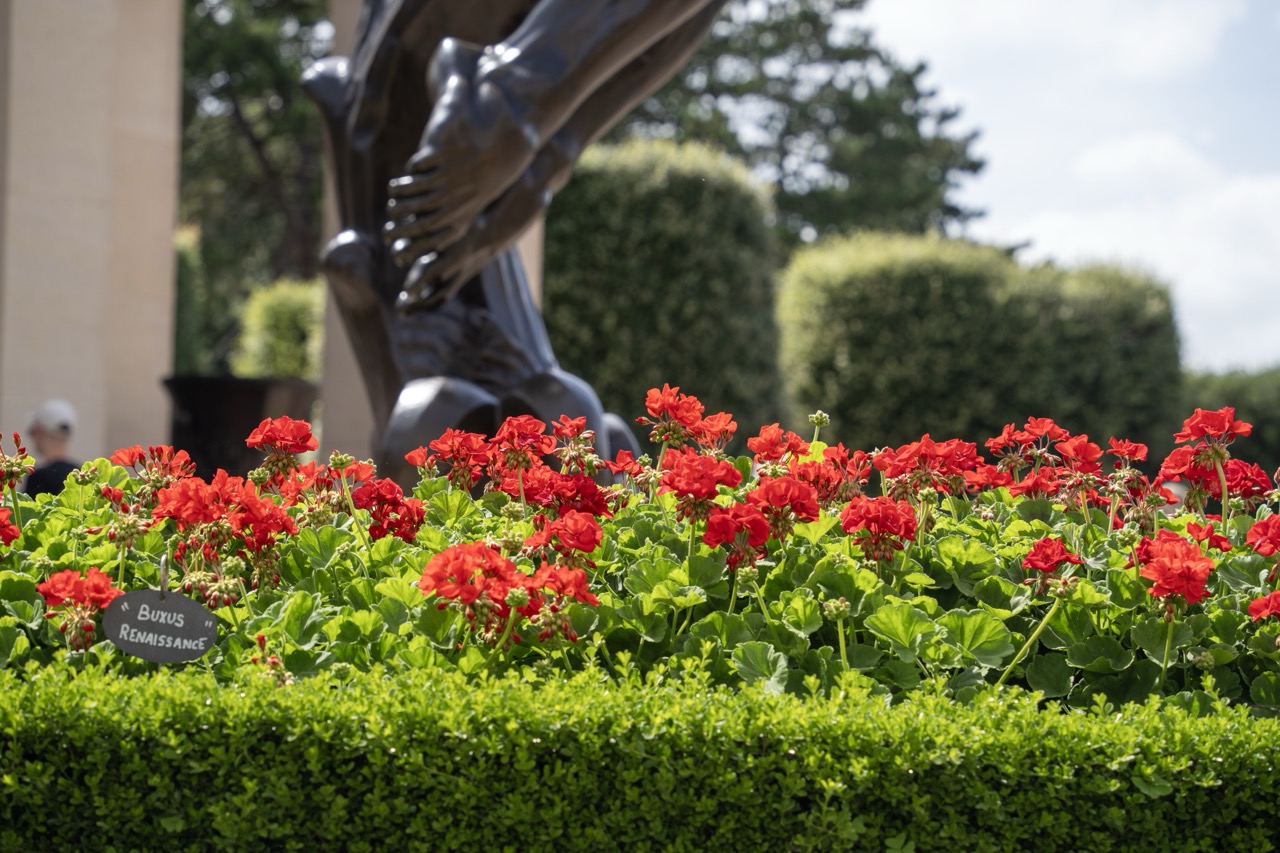

1. Overall Rating (0–10) — 7.0
This photograph captures a harmonious interplay between natural vibrancy and sculptural elegance, where the bold red geraniums create a vivid contrast against the dark bronze of the sculpture. The shallow depth of field draws focus to the flowers while softly blurring the background, lending a painterly quality to the scene. While the composition is strong, the slightly cluttered foreground and indistinct signage detract from the image’s overall clarity and narrative cohesion.
2. Composition (0–10) — 6.5
The foreground flowers dominate the frame, creating a strong visual anchor, while the sculpture in the background provides depth and context. The diagonal line of the hedge leads the eye toward the sculpture, but the off-center placement of the sign and the partial visibility of the sculpture create a slightly unbalanced feel.
3. Lighting (0–10) — 7.0
Natural daylight illuminates the scene evenly, enhancing the saturation of the red blooms and casting soft highlights on the bronze sculpture. The bright, slightly overcast sky prevents harsh shadows, contributing to a balanced and pleasant tonal range.
4. Color & Tone (0–10) — 7.5
The rich reds of the geraniums pop against the lush green foliage and the dark, metallic tones of the sculpture. The color palette is vibrant yet harmonious, with a natural contrast that enhances visual interest without appearing garish.
5. Creativity (0–10) — 7.0
The juxtaposition of organic, living flowers with the static, human-form sculpture creates a compelling dialogue between nature and art. The selective focus adds a layer of artistic intention, elevating the image beyond a simple garden snapshot.
6. Technical Quality (0–10) — 7.5
The image is sharp in the foreground, with clean focus on the flowers and a smooth bokeh in the background. The exposure is well-managed, and there is no noticeable noise or distortion.
7. Emotional Impact (0–10) — 6.5
The image evokes a sense of tranquility and cultivated beauty, inviting the viewer to pause and appreciate the intersection of art and nature. While emotionally resonant, the lack of a clear narrative or human element keeps the emotional connection somewhat detached.


1. Overall Rating (0–10) — 7.5
This photograph captures the delicate elegance of pink roses in full bloom, set against a soft, sunlit green backdrop that evokes a sense of peaceful springtime. The natural vibrancy of the flowers is highlighted by warm, golden light, creating a visually harmonious and inviting scene. While the image is pleasing and well-composed, it leans toward conventional floral photography, lacking a distinctive artistic edge that would elevate it beyond mere documentation.
2. Composition (0–10) — 7.0
The roses are arranged in a natural cluster, with the central bloom drawing the eye effectively. The shallow depth of field isolates the subject while softly blurring the background, creating a pleasing sense of depth. Slight asymmetry adds organic movement, though a tighter crop might enhance focus on the most expressive blooms.
3. Lighting (0–10) — 8.5
Bright, diffused sunlight enhances the soft texture of the petals and brings out the subtle gradients of pink. The light falls evenly across the flowers, minimizing harsh shadows and creating a luminous glow that feels both natural and flattering.
4. Color & Tone (0–10) — 8.0
The palette is rich in warm pinks and lush greens, creating a classic complementary contrast that feels both vibrant and balanced. The tonal range is smooth, with a natural warmth that enhances the image’s springtime mood.
5. Creativity (0–10) — 6.5
While the subject and composition are familiar, the image succeeds through its sensitivity to light and color. It presents a timeless floral moment with a quiet beauty, though it doesn’t push beyond the genre’s traditional aesthetic.
6. Technical Quality (0–10) — 8.5
Sharp focus on the foreground blooms, clean details in the petals and leaves, and a well-controlled depth of field demonstrate strong technical execution. The image is free of noise and distortion.
7. Emotional Impact (0–10) — 7.0
The photograph evokes a sense of calm and gentle joy, reminiscent of a peaceful garden stroll. The soft focus and warm tones invite quiet contemplation, offering a moment of visual serenity that resonates with viewers who appreciate natural beauty.


1. Overall Rating (0–10) — 8.0
This photograph captures a solemn and deeply moving tribute within a military cemetery, where the quiet dignity of uniform white crosses contrasts with the vibrant, living presence of a floral arrangement and flags. The composition draws the viewer into a moment of reverence, emphasizing both collective memory and individual loss. While the scene is visually powerful, the lack of human presence slightly tempers its emotional immediacy, keeping the viewer in the role of observer rather than participant.
2. Composition (0–10) — 8.0
The use of leading lines formed by the rows of crosses creates a strong sense of depth and order, guiding the eye toward the focal point—the decorated grave. The placement of the flowers and flags in the foreground adds visual weight and symbolic importance, while the blurred background enhances focus on the memorial.
3. Lighting (0–10) — 7.5
Natural sunlight bathes the scene in a soft, warm glow, casting gentle shadows that enhance texture and dimension. The light feels authentic and respectful, highlighting the crisp white of the crosses while allowing the green grass to feel alive and vibrant.
4. Color & Tone (0–10) — 8.0
The palette is harmonious and restrained—white, green, and the subtle red, white, and blue of the flags and flowers create a restrained yet emotionally resonant contrast. The tones are rich without being oversaturated, preserving the solemnity of the setting.
5. Creativity (0–10) — 7.5
The image is not overtly experimental, but its power lies in its narrative clarity and emotional restraint. The juxtaposition of the formal, uniform rows with the personal, human gesture of the flowers and flags conveys a powerful story of remembrance and national honor.
6. Technical Quality (0–10) — 8.5
The image is sharp and well-focused, with excellent detail in the texture of the stone crosses and the delicate petals of the flowers. The depth of field is skillfully managed, isolating the subject while maintaining context.
7. Emotional Impact (0–10) — 8.5
The photograph evokes a profound sense of respect and melancholy, inviting quiet reflection on sacrifice and memory. The personal touches—flags, flowers, and inscribed names—transform the scene from a mere landscape into a deeply human moment of mourning and honor.


1. Overall Rating (0–10) — 7.8
This photograph captures the serene elegance of a lily pond, where the interplay of vibrant blossoms and lush green lily pads creates a natural tapestry of life and color. The contrast between the bright white and deep magenta flowers against the rich foliage adds visual energy, while the calm water below enhances the sense of stillness. Though the composition feels slightly dense and lacks a clear focal point, the image successfully conveys the quiet beauty of a thriving aquatic ecosystem.
2. Composition (0–10) — 6.5
The frame is filled with lily pads and flowers, creating a busy foreground that competes for attention. A more deliberate arrangement or use of negative space could guide the eye more effectively.
3. Lighting (0–10) — 8.0
Natural daylight illuminates the scene evenly, highlighting the texture and sheen of the lily pads and enhancing the vividness of the flowers without harsh shadows.
4. Color & Tone (0–10) — 8.5
The palette is rich and harmonious, with the deep greens of the lily pads complementing the bold magenta and crisp white blooms. The contrast between the warm tones of the flowers and the cool dark water adds depth and visual interest.
5. Creativity (0–10) — 7.0
While the subject is familiar, the photographer captures it with an eye for detail and color, transforming a common scene into a visually engaging composition that celebrates nature’s quiet vibrancy.
6. Technical Quality (0–10) — 8.0
The image is sharp and well-focused, with excellent clarity in the textures of the petals and leaves. The exposure is balanced, preserving detail in both highlights and shadows.
7. Emotional Impact (0–10) — 7.5
The photograph evokes a sense of peace and natural harmony, inviting the viewer to pause and appreciate the delicate beauty of the pond. There is a subtle sense of renewal and tranquility that resonates deeply.
Loading map...